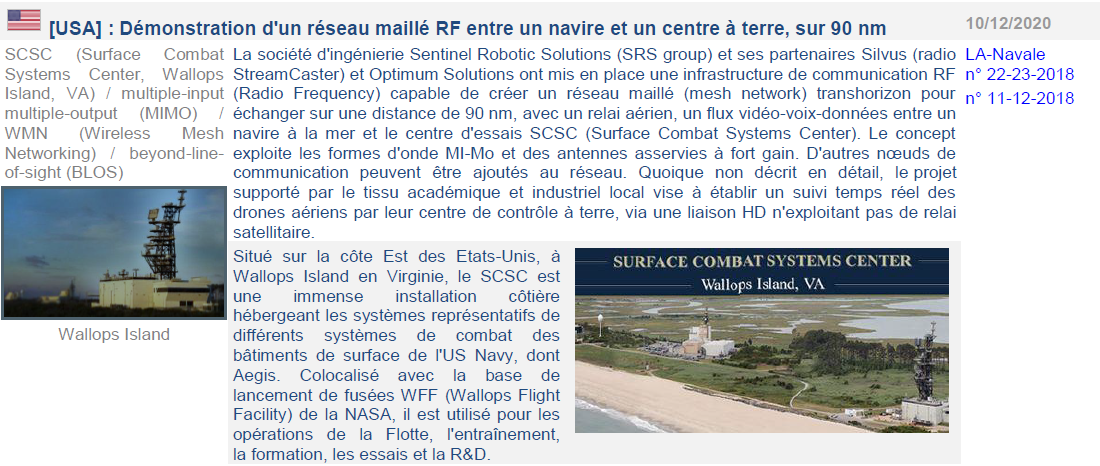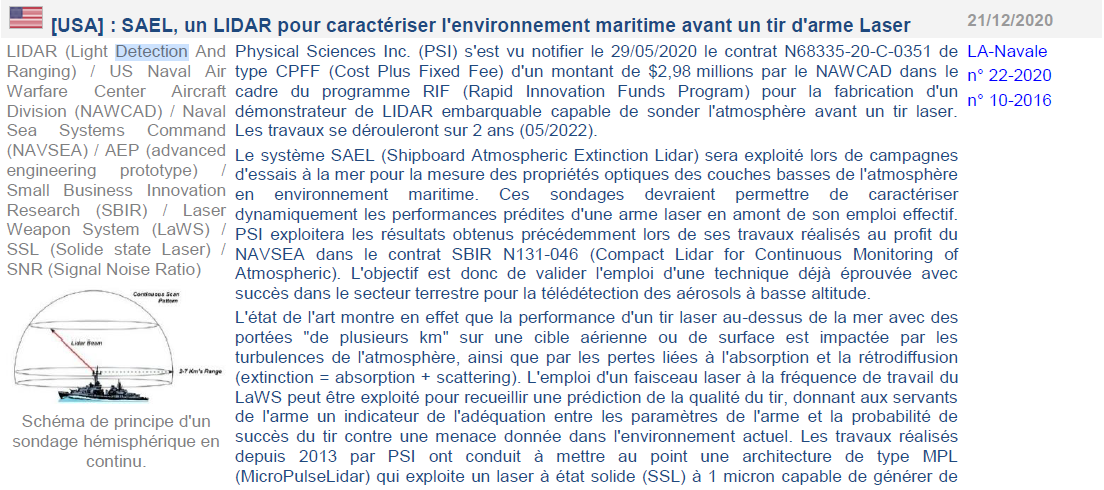

EPS 2020-02
Radar System Market Business Growth Tactics, Future Strategies, Competitive Outlook and Forecast
DBMR has added a new report titledGlobal Radar System Marketwith analysis provides the insights which bring marketplace clearly into the focus and thus help organizations make better decisions. This Radar System Market research report understands the current and future of the market in both developed and emerging markets. The report assists in realigning the business strategies by highlighting the business priorities. It throws light on the segment expected to dominate the industry and market. It forecast the regions expected to witness the fastest growth. This report is a collection of pragmatic information, quantitative and qualitative estimation by industry experts, the contribution from industry across the value chain. Furthermore, the report also provides the qualitative results of diverse market factors on its geographies and Segments… voir l’étude
Electronic Warfare Market Analysis With Key Player – Stryker (US), KARL STORZ SE & Co. KG (Germany), Carl Zeiss Meditec AG (Germany), Leica Microsystems (Germany)
Biz News – 01/07/2021 – This research report which was newly authorized contained a report on Global Electronic Warfare Market which quantified the meaning of the Global Electronic Warfare Market in the market and gave a vivid description of its components which determine how the market structure revolves around the said Electronic Warfare Market. The description entails how technological innovations brought about humongous changes in the market space, business-oriented goals of the Electronic Warfare Market, demand and supply mechanism operating in the market which are a major determining factor behind the growth of the industry, product details and dimensions capable of bringing about organizational changes in the operation mechanism and sales, promotion and product distribution strategies which would help in generating popularity for the market within a given period… voir l’étude
Choisir un pays, comme par exemple « ………3.1. USA »
USA
Le CNO dévoile sa feuille de route CNO-NAVPLAN 2021 lors du 33ème Symposium SNA
Programme (Acteur) Surface Navy Association Symposium (SNA) / Chief of Naval Operations (CNO) / Navigation Plan (NavPlan) / FRAGO (Fragmentary Order)
Le CNO-NAVPLAN s’appuie sur les 2 stratégies « chapeau » :
– NDS’2018 (National Defense Strategy) : « There is no time to waste – our actions in this decade will set the maritime balance of power for the rest of the century ».
– NMS’2018 (National Military Strategy) : « A larger, more lethal, more ready fleet manned by the world’s greatest Sailors is required to maintain our advantage at sea and protect America for years to come ».
A l’occasion du 33ème Symposium de la SNA (Virtual, 11-15/01/2021), l’amiral Mike Gilday, nouveau CNO (Chief of Naval Operations) de l’US Navy, a présenté à la flotte son Navigation Plan (CNO-NavPlan) lors d’une allocution en ligne. S’inscrivant dans le cadre de la stratégie maritime Tri-Service « Advantage at Sea » récemment publiée (et analysée en LA-Navale n° 51-53-2020), cette feuille de route décrit les objectifs fixés à l’US Navy pour « accroître sa puissance navale pour contrôler les mers et projeter sa puissance dans tous les domaines ».
Pour y parvenir, 4 domaines clés sont identifiés :
Les marins – Développer une équipe aguerrie de « guerriers navals »
Préparation – Disposer d’une flotte prête
Capacités – Fournir une flotte plus létale et mieux connectée
Compétence – Disposer d’une flotte plus importante et hybride
Arabie Saoudite
Saudi Arabia makes artificial intelligence a cornerstone of its 2030 vision
 C4ISRnet – 16.01.2021 – BEIRUT — As Saudi Arabia moves forward with an ambitious economic plan, the country’s data and artificial intelligence authority released a multiphase strategy that aims to position the nation as a global leader in the field by 2030. “Data and AI are at the heart of Saudi Arabia’s Vision 2030. By developing our own AI strategy and policies, we have developed the skills and resources that we wish to share with other nations to ensure that all countries are equally prepared to harness the value of AI,” said Majid AlShehry, a spokesperson for the Saudi Data and Artificial Intelligence Authority, a government office linked directly to the prime minister. At the GITEX trade show, the organization showcased three developments: The Boroog platform, a secure government videoconferencing system, used for the G-20 summit. SDAIA disclosed in November that the authority has repelled more than 2 million cyberattacks using special protections it had developed… lire l’article
C4ISRnet – 16.01.2021 – BEIRUT — As Saudi Arabia moves forward with an ambitious economic plan, the country’s data and artificial intelligence authority released a multiphase strategy that aims to position the nation as a global leader in the field by 2030. “Data and AI are at the heart of Saudi Arabia’s Vision 2030. By developing our own AI strategy and policies, we have developed the skills and resources that we wish to share with other nations to ensure that all countries are equally prepared to harness the value of AI,” said Majid AlShehry, a spokesperson for the Saudi Data and Artificial Intelligence Authority, a government office linked directly to the prime minister. At the GITEX trade show, the organization showcased three developments: The Boroog platform, a secure government videoconferencing system, used for the G-20 summit. SDAIA disclosed in November that the authority has repelled more than 2 million cyberattacks using special protections it had developed… lire l’article
Cliquer sur les sous-parties 4.1 à 4.7 pour accéder au contenu.
USA
Réseau maillé RF
Démonstration d’un réseau maillé RF entre un navire et un centre à terre, sur 90 nm
Programme/Acteur SCSC (Surface Combat Systems Center, Wallops Island, VA) / multiple-input multiple-output (MIMO) / WMN (Wireless Mesh Networking) / beyond-line-of-sight (BLOS)
La société d’ingénierie Sentinel Robotic Solutions (SRS group) et ses partenaires Silvus (radio StreamCaster) et Optimum Solutions ont mis en place une infrastructure de communication RF (Radio Frequency) capable de créer un réseau maillé (mesh network) transhorizon pour échanger sur une distance de 90 nm, avec un relai aérien, un flux vidéo-voix-données entre un navire à la mer et le centre d’essais SCSC (Surface Combat Systems Center). Le concept exploite les formes d’onde MI-Mo et des antennes asservies à fort gain. D’autres noeuds de communication peuvent être ajoutés au réseau. Quoique non décrit en détail, le projet supporté par le tissu académique et industriel local vise à établir un suivi temps réel des drones aériens par leur centre de contrôle à terre, via une liaison HD n’exploitant pas de relai satellitaire…
USA
Réseau maillé RF
Démonstration d’un réseau maillé RF entre un navire et un centre à terre, sur 90 nm
Programme/Acteur SCSC (Surface Combat Systems Center, Wallops Island, VA) / multiple-input multiple-output (MIMO) / WMN (Wireless Mesh Networking) / beyond-line-of-sight (BLOS)
La société d’ingénierie Sentinel Robotic Solutions (SRS group) et ses partenaires Silvus (radio StreamCaster) et Optimum Solutions ont mis en place une infrastructure de communication RF (Radio Frequency) capable de créer un réseau maillé (mesh network) transhorizon pour échanger sur une distance de 90 nm, avec un relai aérien, un flux vidéo-voix-données entre un navire à la mer et le centre d’essais SCSC (Surface Combat Systems Center). Le concept exploite les formes d’onde MI-Mo et des antennes asservies à fort gain. D’autres noeuds de communication peuvent être ajoutés au réseau. Quoique non décrit en détail, le projet supporté par le tissu académique et industriel local vise à établir un suivi temps réel des drones aériens par leur centre de contrôle à terre, via une liaison HD n’exploitant pas de relai satellitaire…
Communications satellite
Spectra Group’s SlingShot: Satellite Communications to support Specialist Operations
 Armada International – 24.11.2020 -Conceived and designed to meet demanding Special Forces military requirements, Spectra’s SlingShot is a unique, low size, weight and power (SWaP) system that enables existing UHF and VHF tactical radios to extend their reach into the realm of Beyond Line of Sight (BLOS) Communications on the Move (COTM). By utilising Inmarsat’s commercial L-band Tactical Satellite (L-TAC), SlingShot allows a tactical net to be created over 1000s of kilometers to deliver a comprehensive range of tactical and operational network capabilities. SlingShot provides voice and data capability for Command and Control (C2), encrypted if required, and to support wide-ranging mission-critical applications. With greater capability compared to traditional systems, increased and guaranteed channel availability, and virtually no increase in the training burden, SlingShot is rapidly redefining military tactical communications… lire l’article
Armada International – 24.11.2020 -Conceived and designed to meet demanding Special Forces military requirements, Spectra’s SlingShot is a unique, low size, weight and power (SWaP) system that enables existing UHF and VHF tactical radios to extend their reach into the realm of Beyond Line of Sight (BLOS) Communications on the Move (COTM). By utilising Inmarsat’s commercial L-band Tactical Satellite (L-TAC), SlingShot allows a tactical net to be created over 1000s of kilometers to deliver a comprehensive range of tactical and operational network capabilities. SlingShot provides voice and data capability for Command and Control (C2), encrypted if required, and to support wide-ranging mission-critical applications. With greater capability compared to traditional systems, increased and guaranteed channel availability, and virtually no increase in the training burden, SlingShot is rapidly redefining military tactical communications… lire l’article
Choisir un pays, comme par exemple « ………4.2.1. USA »
USA
Tracking par satellite
L3Harris to build prototype satellite capable of tracking hypersonic weapons
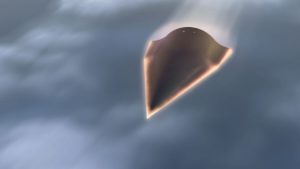 C4ISRnet – 15/01/2021 – WASHINGTON — The Missile Defense Agency awarded L3Harris Technologies a $121 million contract to build a prototype satellite capable of tracking hypersonic weapons, the agency announced Jan. 14. Under the contract, L3Harris is tasked with building an on-orbit prototype demonstration for the agency’s Hypersonic and Ballistic Tracking Space Sensor, a proliferated constellation in low Earth orbit that is capable of detecting and tracking hypersonic weapons. The constellation is designed to fill the gap in the country’s missile defense architecture created by hypersonic weapons, which are dimmer than traditional ballistic missiles, making them harder to see with the nation’s infrared sensors based in geosynchronous orbit… lire l’article
C4ISRnet – 15/01/2021 – WASHINGTON — The Missile Defense Agency awarded L3Harris Technologies a $121 million contract to build a prototype satellite capable of tracking hypersonic weapons, the agency announced Jan. 14. Under the contract, L3Harris is tasked with building an on-orbit prototype demonstration for the agency’s Hypersonic and Ballistic Tracking Space Sensor, a proliferated constellation in low Earth orbit that is capable of detecting and tracking hypersonic weapons. The constellation is designed to fill the gap in the country’s missile defense architecture created by hypersonic weapons, which are dimmer than traditional ballistic missiles, making them harder to see with the nation’s infrared sensors based in geosynchronous orbit… lire l’articleLiDAR
SAEL, un LIDAR pour caractériser l’environnement maritime avant un tir d’arme Laser
Programmes/Acteurs LIDAR (Light Detection And Ranging) / US Naval Air Warfare Center Aircraft Division (NAWCAD) / Naval Sea Systems Command (NAVSEA) / AEP (advanced engineering prototype) / Small Business Innovation Research (SBIR) / Laser Weapon System (LaWS) / SSL (Solide state Laser) / SNR (Signal Noise Ratio)
Physical Sciences Inc. (PSI) s’est vu notifier le 29/05/2020 le contrat N68335-20-C-0351 de type CPFF (Cost Plus Fixed Fee) d’un montant de $2,98 millions par le NAWCAD dans le cadre du programme RIF (Rapid Innovation Funds Program) pour la fabrication d’un démonstrateur de LIDAR embarquable capable de sonder l’atmosphère avant un tir laser. Les travaux se dérouleront sur 2 ans (05/2022).
Le système SAEL (Shipboard Atmospheric Extinction Lidar) sera exploité lors de campagnes d’essais à la mer pour la mesure des propriétés optiques des couches basses de l’atmosphère en environnement maritime. Ces sondages devraient permettre de caractériser dynamiquement les performances prédites d’une arme laser en amont de son emploi effectif. PSI exploitera les résultats obtenus précédemment lors de ses travaux réalisés au profit du NAVSEA dans le contrat SBIR N131-046 (Compact Lidar for Continuous Monitoring of Atmospheric). L’objectif est donc de valider l’emploi d’une technique déjà éprouvée avec succès dans le secteur terrestre pour la télédétection des aérosols à basse altitude.
L’état de l’art montre en effet que la performance d’un tir laser au-dessus de la mer avec des portées « de plusieurs km » sur une cible aérienne ou de surface est impactée par les turbulences de l’atmosphère, ainsi que par les pertes liées à l’absorption et la rétrodiffusion (extinction = absorption + scattering)…
Détection mixte EM – Son
PASS, un démonstrateur de laser aéroporté pour l’imagerie sous-marine par ultrason
Programme (Acteur) PASS (Photoacoustic Airborne Sonar System) / Innovation
Une équipe de la School of Engineering de l’Université de Stanford a développé le démonstrateur PASS (Photoacoustic Airborne Sonar System), un système hybride optique-acoustique permettant d’effectuer des émissions ultrasonores dans l’eau à partir d’un laser aéroporté et de mesurer via des transducteurs les échos des objets immergés ainsi « imagés ». Selon l’étude récemment publiée dans la revue IEEE Access (10/2020), le double franchissement du dioptre (interface air-eau) est rendu possible en combinant lumière et son dans un système suffisamment sensible pour compenser les pertes d’énergie. Nominalement, les ondes sonores passant de l’air à l’eau ou vice versa perdent plus de 99,9% de leur énergie par réflexion ; la lumière et la majorité des ondes électromagnétiques subissent des pertes équivalentes dans l’eau, par absorption. PASS exploite un faisceau laser générant des ondes ultrasonores qui se propagent dans la colonne d’eau et se reflètent sur les objets sous-marins avant de retourner vers la surface ; le récepteur est un « air-coupled CMUT » (capacitive micromachined ultrasonic transducers), un type de MEMS (micro-electromechanical system) qui selon les auteurs constitue un différentiateur majeur au regard des concepts précédents. Un algorithme permet de corriger les déformations liées aux milieux aérien et sous-marin…
France
Observation spatiale EO/IR
Lancement réussi du satellite d’observation militaire CSO-2 (ex-MUSIS)
Programmes/Acteurs Programme MUSIS (Multinational Space-based Imaging System) / CSO (Composante spatiale optique) / Lancement
29.12.2020 – Un 2ème satellite de la constellation d’observation militaire CSO (composante spatiale optique du Programme MUSIS) a été lancé depuis le centre spatial de Kourou (Guyane). Le lancement du CSO-2 intervient 2 ans après celui du CSO-1 (19/12/2018), embarqué, comme son prédécesseur, par un lanceur Soyouz ST-A.
– Le CSO-1 a été placé sur une orbite de 800 km, héliosynchrone phasée (ce qui sera le cas aussi pour le CSO-3 dont le lancement est prévu fin-2021) ;
– Le CSO-2 a été placé sur une orbite plus basse, à 480 km d’altitude, pour offrir des images dites EHR (extrêmement haute résolution)…
Italie
Radar processing
Secrets of Tempest’s ground-breaking radar revealed
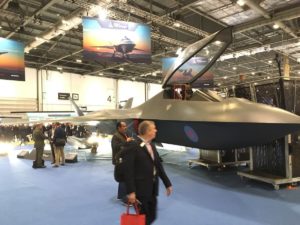 C4ISRnet – 16.01.2021 – ROME — Radar engineers on the Tempest fighter program have said they expect to break data-processing records. The secret, they explain, is all about miniaturization and going digital. The sixth-generation jet — planned by the U.K., Sweden and Italy and set to enter service after 2030 — will bristle with new technology, from its weaponry and propulsion to a virtual cockpit projected inside the pilot’s helmet. But the group set the bar high in October by announcing the fighter’s radar would process a quantity of data equivalent to nine hours of high-definition video — or the internet traffic of a medium-sized city — every second. Few details were given to back up the claim, but now U.K.-based engineers with Italian firm Leonardo, who are working on the radar, have shared clues with Defense News… lire l’article
C4ISRnet – 16.01.2021 – ROME — Radar engineers on the Tempest fighter program have said they expect to break data-processing records. The secret, they explain, is all about miniaturization and going digital. The sixth-generation jet — planned by the U.K., Sweden and Italy and set to enter service after 2030 — will bristle with new technology, from its weaponry and propulsion to a virtual cockpit projected inside the pilot’s helmet. But the group set the bar high in October by announcing the fighter’s radar would process a quantity of data equivalent to nine hours of high-definition video — or the internet traffic of a medium-sized city — every second. Few details were given to back up the claim, but now U.K.-based engineers with Italian firm Leonardo, who are working on the radar, have shared clues with Defense News… lire l’article
RAS
Choisir un pays, comme par exemple « ………4.4.1. USA »
USA
Northrop Grumman to Enable New F-35 Warfighting Capability
 Sea Power magazine – 12.01.2021 – BALTIMORE — Northrop Grumman has received a contract award from Lockheed Martin to enable new functionality to protect the 5th Generation F-35 Lightning II multi-role fighter, Northrop Grumman said in a Jan. 12 release. As part of a collaborative arrangement between Northrop Grumman, BAE Systems and Lockheed Martin, the three companies will integrate Northrop Grumman’s AN/ASQ-242 Integrated Communications, Navigation and Identification (ICNI) and BAE Systems’ AN/ASQ-239 Electronic Warfare/Countermeasures system for optimal operational utility. “This arrangement allows us to collectively provide enhanced capabilities without compromising the size, weight or power of the aircraft,” said Howard Lurie, vice president, F-35 programs, Northrop Grumman. “We are proud to be a primary partner of the F-35 team, providing our U.S. and allied warfighters superior combat effectiveness.” … lire l’article
Sea Power magazine – 12.01.2021 – BALTIMORE — Northrop Grumman has received a contract award from Lockheed Martin to enable new functionality to protect the 5th Generation F-35 Lightning II multi-role fighter, Northrop Grumman said in a Jan. 12 release. As part of a collaborative arrangement between Northrop Grumman, BAE Systems and Lockheed Martin, the three companies will integrate Northrop Grumman’s AN/ASQ-242 Integrated Communications, Navigation and Identification (ICNI) and BAE Systems’ AN/ASQ-239 Electronic Warfare/Countermeasures system for optimal operational utility. “This arrangement allows us to collectively provide enhanced capabilities without compromising the size, weight or power of the aircraft,” said Howard Lurie, vice president, F-35 programs, Northrop Grumman. “We are proud to be a primary partner of the F-35 team, providing our U.S. and allied warfighters superior combat effectiveness.” … lire l’article
Northrop will provide F-16 electronic warfare system
 C4ISRnet – 12.01.2021 – WASHINGTON — Northrop Grumman announced an Air Force award to complete a project for the electronic warfare suite for the F-16 fighter jet. The goal of the prototyping is to protect pilots from increasing radio frequency-guided weapons by detecting, identifying and defeating them, a Jan. 11 announcement from Northrop said. A company did not provide a dollar amount for the award, granted under the Pentagon’s other transaction authority. Initially selected in 2019 to prototype a design, Northrop was asked to design an internally mounted electronic warfare suite and digital radar warning receiver for F-16s, Ryan Tintner, vice president, navigation, targeting and survivability at Northrop, said in an emailed statement… lire l’article
C4ISRnet – 12.01.2021 – WASHINGTON — Northrop Grumman announced an Air Force award to complete a project for the electronic warfare suite for the F-16 fighter jet. The goal of the prototyping is to protect pilots from increasing radio frequency-guided weapons by detecting, identifying and defeating them, a Jan. 11 announcement from Northrop said. A company did not provide a dollar amount for the award, granted under the Pentagon’s other transaction authority. Initially selected in 2019 to prototype a design, Northrop was asked to design an internally mounted electronic warfare suite and digital radar warning receiver for F-16s, Ryan Tintner, vice president, navigation, targeting and survivability at Northrop, said in an emailed statement… lire l’article
NGJ – Mid Band
Raytheon Awarded $34 Million US Navy EA-18G Contract
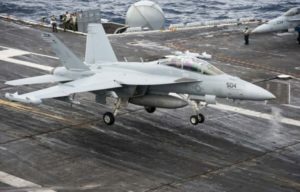 Clearance Jobs – 06/01/2021 – Raytheon Co., El Segundo, California, is awarded a $34,298,657 cost-plus-fixed-fee, indefinite-delivery/indefinite-quantity contract. This contract provides engineering and test support services for the ALQ-249 Next Generation Jammer (NGJ) currently in development for the Navy EA-18G aircraft. The scope includes H16/H18/H20/H22 software support for NGJ pod and integration including requirements analysis, design, development, integration, testing, training and tools related to and in support of ALQ-249 and advanced electronic warfare initiatives for Navy and Foreign Military Sales customers. Work will be performed in El Segundo, California, and is expected to be completed in January 2025… lire l’article
Clearance Jobs – 06/01/2021 – Raytheon Co., El Segundo, California, is awarded a $34,298,657 cost-plus-fixed-fee, indefinite-delivery/indefinite-quantity contract. This contract provides engineering and test support services for the ALQ-249 Next Generation Jammer (NGJ) currently in development for the Navy EA-18G aircraft. The scope includes H16/H18/H20/H22 software support for NGJ pod and integration including requirements analysis, design, development, integration, testing, training and tools related to and in support of ALQ-249 and advanced electronic warfare initiatives for Navy and Foreign Military Sales customers. Work will be performed in El Segundo, California, and is expected to be completed in January 2025… lire l’article
BAE Systems Tapped to Demonstrate P-8 Countermeasure System for U.S. Navy
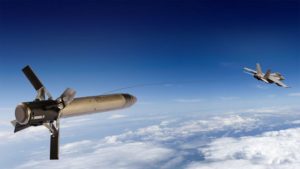 Sea Power – 05/01/2021 – ARLINGTON, Va. — BAE Systems will be demonstrating for the U.S. Navy this spring a podded radio frequency countermeasures (RFCM) self-protection system on the service’s P-8A Poseidon maritime patrol reconnaissance aircraft, the company said. BAE Systems has received a $4 million contract from the Navy to conduct a quick-turnaround demonstration of a new RFCM system for the P-8A, the company said in a Jan. 5 release. The RFCM is designed to jam or decoy missiles guided by RF energy, including radar-guided surface-to-air missiles and some air-to-air missiles. A maritime patrol reconnaissance aircraft is more likely to face these threats while operating against a near-peer competitor than in the more benign environment of the past three decades…lire l’article
Sea Power – 05/01/2021 – ARLINGTON, Va. — BAE Systems will be demonstrating for the U.S. Navy this spring a podded radio frequency countermeasures (RFCM) self-protection system on the service’s P-8A Poseidon maritime patrol reconnaissance aircraft, the company said. BAE Systems has received a $4 million contract from the Navy to conduct a quick-turnaround demonstration of a new RFCM system for the P-8A, the company said in a Jan. 5 release. The RFCM is designed to jam or decoy missiles guided by RF energy, including radar-guided surface-to-air missiles and some air-to-air missiles. A maritime patrol reconnaissance aircraft is more likely to face these threats while operating against a near-peer competitor than in the more benign environment of the past three decades…lire l’article
USA
Warning Receiver
Space Force awards Lockheed Martin $4.9 billion for missile warning satellites
 C4ISRnet – 05/01/2021 – WASHINGTON — Lockheed Martin secured $4.9 billion to build three missile warning satellites for the U.S. Space Force, according to a Jan. 4 announcement. The company already received $2.9 billion in 2018 to begin work on the satellites, which will be part of the Next Generation Overhead Persistent Infrared (Next Gen OPIR) system. That contract covered development through critical design review, completed in October 2020. With that step finished, the program was ready to move forward with manufacturing the satellites… lire l’article
C4ISRnet – 05/01/2021 – WASHINGTON — Lockheed Martin secured $4.9 billion to build three missile warning satellites for the U.S. Space Force, according to a Jan. 4 announcement. The company already received $2.9 billion in 2018 to begin work on the satellites, which will be part of the Next Generation Overhead Persistent Infrared (Next Gen OPIR) system. That contract covered development through critical design review, completed in October 2020. With that step finished, the program was ready to move forward with manufacturing the satellites… lire l’article
USA
Warning Receiver
Space Force awards Lockheed Martin $4.9 billion for missile warning satellites
 C4ISRnet – 05/01/2021 – WASHINGTON — Lockheed Martin secured $4.9 billion to build three missile warning satellites for the U.S. Space Force, according to a Jan. 4 announcement. The company already received $2.9 billion in 2018 to begin work on the satellites, which will be part of the Next Generation Overhead Persistent Infrared (Next Gen OPIR) system. That contract covered development through critical design review, completed in October 2020. With that step finished, the program was ready to move forward with manufacturing the satellites… lire l’article
C4ISRnet – 05/01/2021 – WASHINGTON — Lockheed Martin secured $4.9 billion to build three missile warning satellites for the U.S. Space Force, according to a Jan. 4 announcement. The company already received $2.9 billion in 2018 to begin work on the satellites, which will be part of the Next Generation Overhead Persistent Infrared (Next Gen OPIR) system. That contract covered development through critical design review, completed in October 2020. With that step finished, the program was ready to move forward with manufacturing the satellites… lire l’article
UK
EW Countermeasures developed with Artificial Intelligence in mind
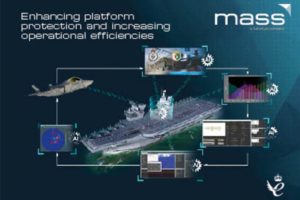 Armada International – 07.06.2018 – Artificial intelligence (AI) can enable an evolution in Electronic Warfare countermeasures development by automating the process in which the threat is identified and an effective countermeasure is developed, according to experts at Cohort company MASS.
Armada International – 07.06.2018 – Artificial intelligence (AI) can enable an evolution in Electronic Warfare countermeasures development by automating the process in which the threat is identified and an effective countermeasure is developed, according to experts at Cohort company MASS.
The EW specialists will outline the progress they have made in designing an end to end process that supports the full cycle of threat vulnerability analysis and countermeasure development (TVACD) and how automation can enhance this process in a presentation at EW Europe in Lausanne on 5-7 June. MASS Mission Data Technical Services Manager, Brian Tottingham, says that significant operational advantage can be delivered by using automated analysis of threat parameters and exploiting the advances in machine learning to extract aerodynamic, guidance, control, fuse, warhead and signal processing data from open source intelligence (OSINT)… lire l’article
UK
EW Countermeasures developed with Artificial Intelligence in mind
 Armada International – 07.06.2018 – Artificial intelligence (AI) can enable an evolution in Electronic Warfare countermeasures development by automating the process in which the threat is identified and an effective countermeasure is developed, according to experts at Cohort company MASS.
Armada International – 07.06.2018 – Artificial intelligence (AI) can enable an evolution in Electronic Warfare countermeasures development by automating the process in which the threat is identified and an effective countermeasure is developed, according to experts at Cohort company MASS.
The EW specialists will outline the progress they have made in designing an end to end process that supports the full cycle of threat vulnerability analysis and countermeasure development (TVACD) and how automation can enhance this process in a presentation at EW Europe in Lausanne on 5-7 June. MASS Mission Data Technical Services Manager, Brian Tottingham, says that significant operational advantage can be delivered by using automated analysis of threat parameters and exploiting the advances in machine learning to extract aerodynamic, guidance, control, fuse, warhead and signal processing data from open source intelligence (OSINT)… lire l’article
USA
IQ-Analog Antenna Processor ASIC Powers Lockheed Martin Phased Array Sensors
 Design & Reuse – 06/01/2021 – SAN DIEGO, Jan. 6, 2021 – IQ-Analog Corporation today announced that its Full-Spectrum Conversion® wideband transceiver F1000 Antenna Processor Unit (APU) has been successfully integrated into Lockheed Martin Corporation’s next generation digital prototype active electronically scanned phased array (AESA) sensor. The F1000 is a monolithic application specific integrated circuit (ASIC) that was developed by IQ-Analog to address next generation radar, communications and electronic warfare systems that are transitioning from legacy analog to all-digital antenna processing… lire l’article
Design & Reuse – 06/01/2021 – SAN DIEGO, Jan. 6, 2021 – IQ-Analog Corporation today announced that its Full-Spectrum Conversion® wideband transceiver F1000 Antenna Processor Unit (APU) has been successfully integrated into Lockheed Martin Corporation’s next generation digital prototype active electronically scanned phased array (AESA) sensor. The F1000 is a monolithic application specific integrated circuit (ASIC) that was developed by IQ-Analog to address next generation radar, communications and electronic warfare systems that are transitioning from legacy analog to all-digital antenna processing… lire l’article
USA
IQ-Analog Antenna Processor ASIC Powers Lockheed Martin Phased Array Sensors
 Design & Reuse – 06/01/2021 – SAN DIEGO, Jan. 6, 2021 – IQ-Analog Corporation today announced that its Full-Spectrum Conversion® wideband transceiver F1000 Antenna Processor Unit (APU) has been successfully integrated into Lockheed Martin Corporation’s next generation digital prototype active electronically scanned phased array (AESA) sensor. The F1000 is a monolithic application specific integrated circuit (ASIC) that was developed by IQ-Analog to address next generation radar, communications and electronic warfare systems that are transitioning from legacy analog to all-digital antenna processing… lire l’article
Design & Reuse – 06/01/2021 – SAN DIEGO, Jan. 6, 2021 – IQ-Analog Corporation today announced that its Full-Spectrum Conversion® wideband transceiver F1000 Antenna Processor Unit (APU) has been successfully integrated into Lockheed Martin Corporation’s next generation digital prototype active electronically scanned phased array (AESA) sensor. The F1000 is a monolithic application specific integrated circuit (ASIC) that was developed by IQ-Analog to address next generation radar, communications and electronic warfare systems that are transitioning from legacy analog to all-digital antenna processing… lire l’article
France
Une quatrième FREMM et un troisième PSP passeront au double équipage cette année
Mer et Marine – 13.01.2021 – La Marine nationale continue en 2021 de passer des unités au double équipage. Après les frégates multi-missions (FREMM) Aquitaine et Languedoc (basées à Brest et Toulon) en 2019, puis la Bretagne (Brest) en 2020, ce sera au tour de la Provence, stationnée à Toulon, de connaitre cette importante manœuvre RH à l’été. Le passage au double équipage constitue une évolution de la gestion des ressources humaines voulue par la marine française afin d’offrir davantage de visibilité aux marins pour leur vie privée et de stabilité à la programmation de l’activité opérationnelle à la mer ainsi que l’entrainement et la formation. Cette évolution permet également d’augmenter le nombre de jours à la mer des frégates, qui sont particulièrement sollicitées. Ou comme ce fut le cas pour le Languedoc resté six mois dans la région du Golfe arabo-persique l’année dernière, d’effectuer une relève d’équipage alors que le bâtiment est déployé à l’étranger… lire l’article
Entraînement
Face aux menaces, la Marine relève son niveau d’entrainement
Mer et Marine – 06.01.2021 – En décembre, la marine française a organisé pendant deux semaines un nouvel exercice multi-luttes de haut niveau dans un cadre interarmées et avec la participation de moyens étrangers. « ZEST », c’est son nom, illustre l’évolution des entrainements de Marine nationale vers un modèle plus musclé, pour tenir compte d’un accroissement sensible des menaces dans le milieu maritime. Objectif : mieux préparer les forces à des interventions dans des zones de plus en plus « contestées », soumises à différentes formes de brouillage, voire de cyber-attaques, et globalement, en toile de fond, un retour possible à des conflits de haute intensité dans les années qui viennent. Car une longue période de relative sécurité sur les océans après la chute de l’URSS, les océans sont redevenus un espace de dangers. « Ce qui change radicalement pour nous, c’est le grand retour de l’usage stratégique de la mer. Nous nous trouvons dans un nouveau cycle géopolitique… lire l’article
France
Une quatrième FREMM et un troisième PSP passeront au double équipage cette année
Mer et Marine – 13.01.2021 – La Marine nationale continue en 2021 de passer des unités au double équipage. Après les frégates multi-missions (FREMM) Aquitaine et Languedoc (basées à Brest et Toulon) en 2019, puis la Bretagne (Brest) en 2020, ce sera au tour de la Provence, stationnée à Toulon, de connaitre cette importante manœuvre RH à l’été. Le passage au double équipage constitue une évolution de la gestion des ressources humaines voulue par la marine française afin d’offrir davantage de visibilité aux marins pour leur vie privée et de stabilité à la programmation de l’activité opérationnelle à la mer ainsi que l’entrainement et la formation. Cette évolution permet également d’augmenter le nombre de jours à la mer des frégates, qui sont particulièrement sollicitées. Ou comme ce fut le cas pour le Languedoc resté six mois dans la région du Golfe arabo-persique l’année dernière, d’effectuer une relève d’équipage alors que le bâtiment est déployé à l’étranger… lire l’article
Entraînement
Face aux menaces, la Marine relève son niveau d’entrainement
Mer et Marine – 06.01.2021 – En décembre, la marine française a organisé pendant deux semaines un nouvel exercice multi-luttes de haut niveau dans un cadre interarmées et avec la participation de moyens étrangers. « ZEST », c’est son nom, illustre l’évolution des entrainements de Marine nationale vers un modèle plus musclé, pour tenir compte d’un accroissement sensible des menaces dans le milieu maritime. Objectif : mieux préparer les forces à des interventions dans des zones de plus en plus « contestées », soumises à différentes formes de brouillage, voire de cyber-attaques, et globalement, en toile de fond, un retour possible à des conflits de haute intensité dans les années qui viennent. Car une longue période de relative sécurité sur les océans après la chute de l’URSS, les océans sont redevenus un espace de dangers. « Ce qui change radicalement pour nous, c’est le grand retour de l’usage stratégique de la mer. Nous nous trouvons dans un nouveau cycle géopolitique… lire l’article
Choisir un pays, comme par exemple « ………5.1. USA »
USA
DARPA – Long Range Anti-Ship Missile (LRASM)
Pentagon’s weapons tester gives update on Navy’s new long-range anti-ship missile
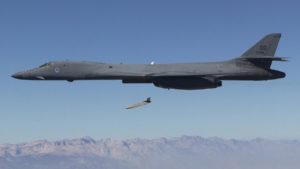 The Long Range Anti-Ship Missile (LRASM) Deployment Office (LDO) is a partnership of DARPA, the United States Navy (NAVAIR), and the United States Air Force to provide an improved offensive anti-surface warfare capability to the fleet on a compressed timeline.
The Long Range Anti-Ship Missile (LRASM) Deployment Office (LDO) is a partnership of DARPA, the United States Navy (NAVAIR), and the United States Air Force to provide an improved offensive anti-surface warfare capability to the fleet on a compressed timeline.
DefenseNews – 14.01.2021 – WASHINGTON — The U.S. Navy’s new Long Range Anti-Ship Missile must go through more rigorous and realistic testing, according to the 2020 annual report from the director of operational test and evaluation. Citing “multiple hardware and software failures” in the first iteration of the LRASM missile, the DOT&E report calls on the Navy to put the new LRASM 1.1 through a rigorous testing process under realistic combat conditions to ensure it will “demonstrate mission capability in operationally realistic environments.” The LRASM is a weapon that has generated a good deal of excitement among Navy leaders. It has a published range of about 300 nautical miles, is jam resistant, and is designed to locate targets with onboard sensors rather than relying on guidance from another source such as a drone’s sensors or another ship. The missile is also difficult to detect… lire l’article
ONR – Système de surveillance maritime
AMASS, système stratégique de surveillance océanique (ONR) : Pas de contrat avant 2021
Avis de l’ONR « Affordable Mobile ASW Surveillance System (AMASS) : Notice n° N00014-20-S-SN02 sur beta.SAM.gov le 07/08/2020.
L’appel d’offres N00014-20-S-SN02 publié par l’ONR (Office of Naval Research) a été par deux fois prolongé, apparemment afin de permettre une évaluation plus approfondie des offres. Pour l’heure, une rencontre de type « Industry day » (classifiée Secret Défense) s’est effectivement tenue le 11/03/2020 dans les locaux de l’ONR (headquarters) à Arlington (VA), rassemblant des participants sélectionnés sur invitation. La date de fourniture des « Livres blancs » a été maintenue au 02/04/2020 et les offres des candidats retenus ont pu être remises jusqu’au 15/06/2020 (+1 mois vis-à-vis du calendrier initial). En revanche, l’évaluation des propositions a été reportée du 29/05 au 04/09/2020. Surtout, alors que les 1ers contrats étaient attendus pour le tout début de l’annuité FY-21 (29/10/2020), ils ne seront désormais pas notifiés avant le 03/09/2021 (+11 mois).
Aucune information sur le type de système demandé ou offert n’est encore publiée. L’objectif annoncé d’AMASS (Affordable Mobile Anti-Submarine Warfare Surveillance System) est, en soutien du PMS-485 MSS (Maritime Surveillance Systems) en charge des programmes de systèmes stratégiques de surveillance océanique, de financer des développements exploratoires en LSM en vue de pouvoir disposer à terme d’un système persistent de surveillance maritime pour les grands fonds à base de capteurs actifs, « qui révolutionne la lutte ASM à long terme » : Devant dérisquer la future composante active des systèmes déployables DSS (Deployable Surveillance Systems), AMASS vise ainsi la détection à très grande portée des nouvelles menaces sous-marines, en complément des systèmes FSS (Fixed Surveillance Systems) et MSS (Mobile Surveillance Systems/SURTASS) pour la lutte ASM de théâtre TASW (Theater Anti-Submarine Warfare) à l’échelle mondiale, et à « bas coût ».
